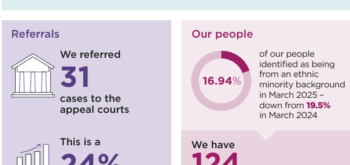[contextly_auto_sidebar id=”AIS03DtwhyCIFdjiZPCRWgsOseGAe2jZ”]
The Justice Gap has since its inception been a valuable but rare source of informal reporting on matters relating to miscarriages of justice, providing casual and regular contributors with an outlet to raise issues of concern. Wider media interest in the subject has been limited and ad hoc in recent years, with no appetite or funding for flagship investigative reporting. However, things are changing, thanks in no small part to the popularity of Serial . For anyone who hasn’t yet heard of Serial, it is a US podcast that was aired over 12 episodes from October 2014, telling the true story of the murder conviction of Adnan Syed, who has always maintained his innocence. Narrated by an investigative journalist, evidence alternating between supporting and casting doubt on the conviction was rolled out weekly in layers to a hooked online audience. In true whodunnit style, the listener was left not knowing whether this conviction was safe when the final episode aired in December.
First innocence project appeal success
At around this time, unrelated things were happening co-incidentally, which perhaps combined to fan the flames of UK media interest in miscarriages of justice. Cardiff Law School’s overturning of the Dwaine George conviction in December 2014 was within a week or so of Serial ending. Before this, Dr Michael Naughton had spent a decade sowing the seeds of innocence in the UK, attracting varying degrees of press interest. Then, after ten years of diverse UK university innocence project activity, there was a collective sigh of relief that it was possible to overturn a conviction, albeit with a recognition that it will probably be several years before it happens again. MPs take note Also, at the same time the Justice Select Committee Review into the Criminal Cases Review Commission (CCRC) was on the horizon. Evidence has now been given by academics, legal practitioners, members of the original Royal Commission, the CCRC, and others. We are expecting the Committee to report in March, but with the May election and with Chris Grayling’s response to the same Committee’s report on Joint Enterprise, who knows what will result?
The student appeal
Immediately following our December appeal success, we were contacted by various newspapers and other outlets for interviews – the press loves a “first”. The story of student “Freedom Fighters” clearly hit the right note (for example BBC’s Law in Action) . Surprisingly perhaps, interest has continued since then, and this has to be down to the Serial effect. It’s been a steep learning curve for us. Most reporting has been positive. Editing is outside our control, of course, but most end products have been fair even if they haven’t always given credit to everyone involved in this difficult past decade. However, some recent reports have been more mischievous, resulting in out-of-context selective misquoting. Rather than having sleepless nights agonising over this, my skin has thickened. The world hasn’t stopped revolving and I hope that most people “in the know” will take a sensible view generally of press coverage. But what the journalists and television producers obsessed with creating a Serial-style programme in the UK may not appreciate is that there may be more than just a handful of genuine miscarriage of justice cases. There may be dozens, or even hundreds.
How many miscarriages of justice?
So, on the subject of being (sometimes mis)quoted, are there “hundreds of people” who have been wrongly convicted in the UK? Notwithstanding the difficulties of quantifying such a disputed concept, research at the time of the Royal Commission in the early 1990s (Zander and Henderson 1993) suggested that between 2% and 17% of convictions were “problematic”. Michael Naughton (2003 and 2007) suggests that the number is in the thousands based on successful appeals including from magistrates’ courts. If we place this in the context of reducing legal representation because of disappearing legal aid and the doubling of the prison population in the last 20 years, it is little wonder that every organisation trying to address miscarriages of justice is swamped with applications. Even taking Zander and Henderson’s lowest estimate of 2% , given the prison population of 1993 (around 40,000) this would have been about 800 people. Today that conservative estimate can be doubled even disregarding all the other reasons why wrongful convictions may be increasing. So a figure of “hundreds” is arguably fanciful only in its underestimation.
The Birmingham 26?
One statistic that has recently given me food for thought is something that Professor Michael Zander mentioned in his recent evidence to the Select Committee. Jon Robins has referred to it as “The Birmingham 26”, an evocative label that should prompt alarm bells, in my view. It relates to a finding in Dr Stephen Heaton’s research on the concept of innocence post-conviction, published in December 2013, in particular his “Troubling Cases” (on page 270). For his research, Stephen was allowed rare access to the CCRC’s files, using a final sample of 172 cases where he “examined the application of the real possibility test”. He said: “In 26 of these cases, the decision was one that I found troubling. They were cases that I might have referred. There is a need for caution here. To draw any conclusion from these cases requires more than a disagreement on my part about the decision in an individual case.” It was reassuring that Stephen considered the 172 files to have been exhaustively reviewed by the CCRC. But what is troubling is that although Stephen “felt them worthy of referral” he “found in each case that the [CCRC] had sought to apply the test as they anticipated that the [Court of Appeal] would do so”. He concludes that “whatever my doubts, if I had been charged with discharge of the statutory real possibility test I would have reached the same conclusion”. “The fact remains however that this small body of cases troubled me”, and he concludes that “the real obstacle lies in the application of the real possibility test” (page 306); that the real issue is with the Court of Appeal and that legislative change is needed to make any difference. Stephen has naturally caveated his findings, and by way of my own caveat, I have not yet studied his research in full (391 pages). But how, if at all, will the Justice Select Committee act on what Professor Zander brought to their attention in this regard? I don’t pretend that meaningful statistical conclusions can be drawn from this sample. Nevertheless this represents 15% of cases that had been reviewed by the CCRC which were considered by them for referral. This 15% are of concern to an academic researcher who is respected by the CCRC, someone who has had unique detailed access to more than 400 CCRC files. It concerns Stephen. It should concern the rest of us too, including the CCRC. It reinforces the point that most of those giving evidence recently have made ie. that the real possibility test is a real bar to correcting wrongful convictions. This 15% is not just a percentage figure – let’s not forget they are 26 people challenging their convictions, who have nil chance of getting to appeal because of the restrictions of the current test.
The search for “suitable” cases
Returning to current media interest, Cardiff and others have recently had approaches from various production companies keen to make a Serial-type podcast/documentary/drama. We think this is good news provided it can be about issues rather than pure “entertainment”. Whether it will progress beyond the exploration stage, and how long the Serial-driven media frenzy will last, who knows? It won’t be easy for the various production companies to identify potential cases to feature. They are working to very specific briefs, and there are obviously confidentiality and case sensitivity issues. But where there’s a will (and a BBC/Channel 4 development grant) there’s a way, so no doubt we will be seeing a UK production some time soon. It would be good if this keeps the issue of miscarriages of justice in the spotlight, and adds to the pressure for change. We want to share this potential opportunity to showcase the “right” case(s) that might illustrate wider problems we face in our casework. So if anyone has case suggestions, with no publicity, case sensitivity or confidentiality issues, please free to email me directly and I will happily pass on information to any companies that approach us.








